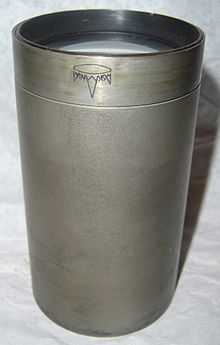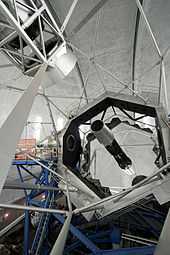Objective (optics)

In an optical instrument, the objective is the optical element that gathers light from the object being observed and focuses the light rays to produce a real image. Objectives can be single lenses or mirrors, or combinations of several optical elements. They are used in microscopes, telescopes, cameras, slide projectors, CD players and many other optical instruments. Objectives are also called object lenses, object glasses, or objective glasses.
Types
Microscope
The objective lens of a microscope is the one at the bottom near the sample. At its simplest, it is a very high-powered magnifying glass, with very short focal length. This is brought very close to the specimen being examined so that the light from the specimen comes to a focus inside the microscope tube. The objective itself is usually a cylinder containing one or more lenses that are typically made of glass; its function is to collect light from the sample.
A typical microscope has several objective lenses with different focal lengths screwed into a circular nose piece which may be rotated to select the required lens. The lenses are typically designed to be parfocal, which means that when one changes from one to another the sample stays in focus.
Microscope objectives are characterized by two parameters: magnification and numerical aperture. The former typically ranges from 4× to 100×, while the latter ranges from 0.10 to 1.25, corresponding to focal lengths of about 40 to 2 mm, respectively. For high magnification applications, an oil-immersion objective or water-immersion objective has to be used. The objective is specially designed and refractive index matching oil or water must fill the air gap between the front element and the object to allow the numerical aperture to exceed 1, and hence give greater resolution at high magnification. Numerical apertures as high as 1.6 can be achieved with oil immersion.[1]
Photography and imaging
Camera lenses (usually referred to as "photographic objectives" instead of simply "objectives"[2]) need to cover a large focal plane so are made up of a number of optical lens elements to correct optical aberrations. Image projectors (such as video, movie, and slide projectors) use objective lenses that simply reverse the function of a camera lens,[3] with lenses designed to cover a large image plane and project it at a distance onto another surface.
Telescope
In a telescope the objective is the lens at the front end of a refractor or the image-forming primary mirror of a reflecting or catadioptric telescope. A telescope's light-gathering power and angular resolution are both directly related to the diameter (or "aperture") of its objective lens or mirror. The larger the objective, the dimmer the object it can view and the more detail it can resolve.
-

A photographic objective, focal length 50 mm, aperture 1:1.4
-

Diastar projection objective from a 35 mm movie projector, (focal length 400 mm).
-

Two Leica oil immersion microscope objective lenses; left 100×, right 40×.
-

The segmented hexagonal objective mirror of the Keck 2 Telescope
See also
References
- ↑ Kenneth, Spring; Keller, H. Ernst; Davidson, Michael W. "Microscope objectives". Olympus Microscopy Resource Center. Retrieved 29 Oct 2008.
- ↑ The Focal encyclopedia of photography by Leslie Stroebel, Richard D. Zakia, 1993 edition, page 515
- ↑ Light fantastic: the art and design of stage lighting, Max Keller, Johannes Weiss - page 71